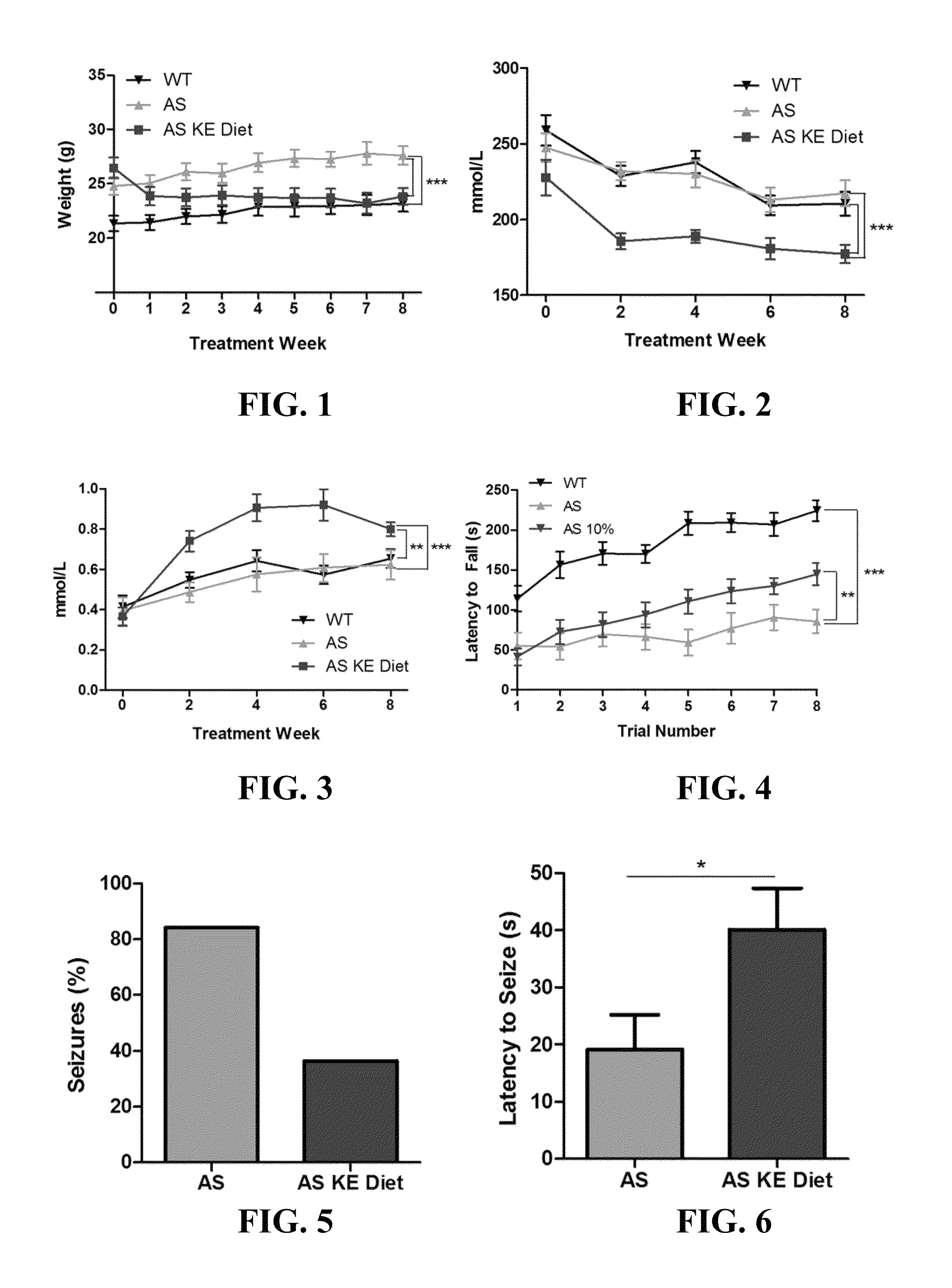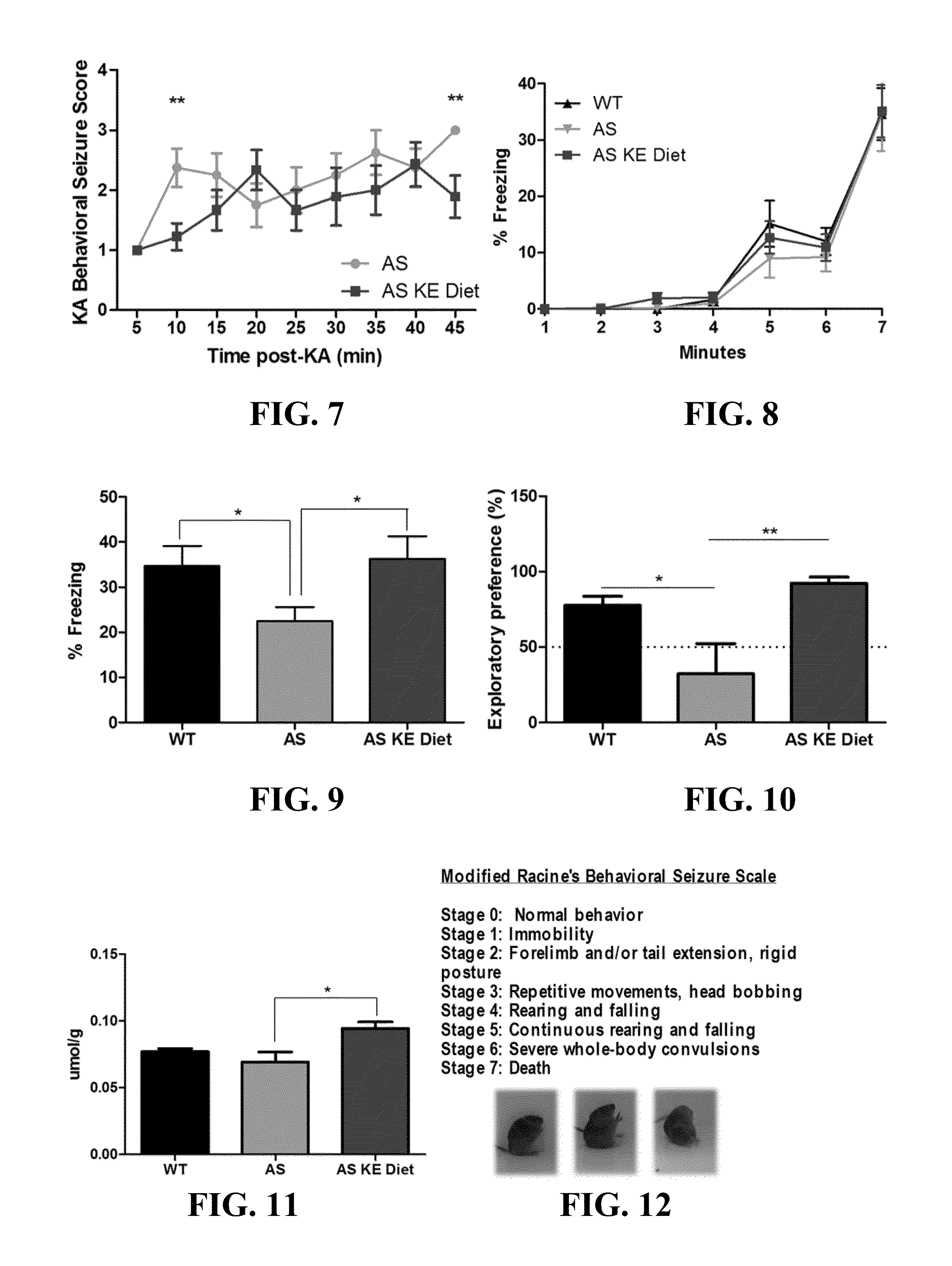Ketone esters for treatment of angelman syndrome
Active Publication Date: 2016-06-14
UNIV OF SOUTH FLORIDA
View PDF2 Cites 4 Cited by
- Summary
- Abstract
- Description
- Claims
- Application Information
AI Technical Summary
Benefits of technology
The patent text describes the use of a ketone ester supplement to treat patients with AS. The symptoms of AS include gastrointestinal abnormalities, olfactory aversions, low body weight, and reduced muscle tone. By using this supplement, researchers found that it can help improve seizure control, motor function, and cognitive performance in patients with AS. This treatment could therefore increase life expectancy and improve overall cognition, especially if treatment is started early. The technical effect of the patent text is the use of ketone esters to treat patients with AS and the potential for improved outcomes.
Problems solved by technology
Dietary therapeutic approaches can be especially problematic in patients suffering from AS.
Method used
the structure of the environmentally friendly knitted fabric provided by the present invention; figure 2 Flow chart of the yarn wrapping machine for environmentally friendly knitted fabrics and storage devices; image 3 Is the parameter map of the yarn covering machine
View moreImage
Smart Image Click on the blue labels to locate them in the text.
Smart ImageViewing Examples
Examples
Experimental program
Comparison scheme
Effect test
embodiment 1
[0054]A method of treating Angelman Syndrome (AS) in a subject, comprising administering a therapeutically effective amount of a ketone ester to the subject.
embodiment 2
[0055]The method of embodiment 1, wherein the ketone ester is derived from acetoacetate (AcAc).
embodiment 3
[0056]The method of embodiment 1 or 2, wherein the ketone ester is a R,S-1,3-butanediol acetoacetate ester.
the structure of the environmentally friendly knitted fabric provided by the present invention; figure 2 Flow chart of the yarn wrapping machine for environmentally friendly knitted fabrics and storage devices; image 3 Is the parameter map of the yarn covering machine
Login to View More PUM
| Property | Measurement | Unit |
|---|---|---|
| Time | aaaaa | aaaaa |
Login to View More
Abstract
The invention concerns a method of treating Angelman Syndrome (AS) in a subject, comprising inducing ketosis in the subject by administering a therapeutically effective amount of a ketone ester, such as an R,S-1,3-butanediol acetoacetate ester, wherein administration of the ketone ester elevates the blood ketone level in the subject. Other aspects of the invention include a method of increasing cognitive function and / or motor function in a subject with AS; and a method of decreasing seizures and increasing the latency to seize in a subject with AS.
Description
BACKGROUND OF THE INVENTION[0001]Angelman Syndrome (AS) is a devastating neurological disorder with a prevalence of 1 in 15,000 that currently has no cure. AS presents with ataxia, frequent smiling, and laughter, lack of speech, and severe, debilitating seizures. Epilepsy in AS is often refractory to many prescribed medications, and frequently involves many seizure types. Furthermore, chronic, intractable epilepsy is shown to cause hippocampal damage and is associated with cognitive decline. The severity of seizures and lack of consistently effective anti-epileptic medications for AS patients demonstrates a considerable need for other therapeutic options.[0002]Research in the AS field primarily focuses on finding an overall treatment for the disorder, without specific examination of the devastating epilepsy phenotype. Epilepsy is a common cause of death in AS and is present in over 80% of AS patients, with 77% of these patients remaining refractory. Unfortunately, common anti-epilep...
Claims
the structure of the environmentally friendly knitted fabric provided by the present invention; figure 2 Flow chart of the yarn wrapping machine for environmentally friendly knitted fabrics and storage devices; image 3 Is the parameter map of the yarn covering machine
Login to View More Application Information
Patent Timeline
 Login to View More
Login to View More IPC IPC(8): A61K31/22A61K31/225
CPCA61K31/22A61K31/225A61K31/19
Inventor WEEBER, EDWIN JOHNCIARLONE, STEPHANIE LYNND'AGOSTINO, DOMINIC PAUL
Owner UNIV OF SOUTH FLORIDA
Features
- R&D
- Intellectual Property
- Life Sciences
- Materials
- Tech Scout
Why Patsnap Eureka
- Unparalleled Data Quality
- Higher Quality Content
- 60% Fewer Hallucinations
Social media
Patsnap Eureka Blog
Learn More Browse by: Latest US Patents, China's latest patents, Technical Efficacy Thesaurus, Application Domain, Technology Topic, Popular Technical Reports.
© 2025 PatSnap. All rights reserved.Legal|Privacy policy|Modern Slavery Act Transparency Statement|Sitemap|About US| Contact US: help@patsnap.com



